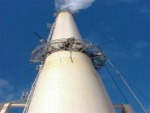Researchers from the University of Murcia have studied the effects of contamination at petrol stations that is potentially harmful to health, which can be noted in buildings less than 100 meters from the service stations.
Princeton University plans to install a 5.3-megawatt solar collector field.
Though the Great Lakes are the largest freshwater system on Earth, the basin has the potential for local shortages, according to a new basinwide water availability assessment by the U.S. Geological Survey.
Technip, in association with Nénuphar, Converteam and EDF Energies nouvelles is launching the Vertiwind project to test a pre-industrial prototype of a vertical-axis offshore floating wind turbine.
The air pollution control measures that were put in place in Beijing during the 2008 Olympic Games – if continued – would cut almost in half the lifetime risk of lung cancer for the area's residents from certain inhaled pollutants.
The aggressive wolverine may not be powerful enough to survive climate change in the contiguous United States, according to new research by the National Center for Atmospheric Research.
The agency, along with HUD and DOT, is providing technical assistance to help communities achieve their sustainable planning goals.
Company says hazardous material cleanup can be as simple as putting its mattress under the spill.
The American Council of Engineering Companies, the American Public Works Association, and the American Society of Civil Engineers plan to develop a performance-based rating system that hinges on environmental, economic and social sustainability considerations.
SOCMA President Sloan suggested that TSCA has been effective and modernizing the law is an action that should be carefully undertaken.

Taking into account revenues for ambient monitoring systems, intermittent stack sampling, and process control using pollutant analyzers, the world market could be more than $3 billion, according to McIlvaine's latest report.
We need more data, the American Bird Conservancy said, adding that environmental oversight or assessment can help developers be certain that significant numbers of birds will not be harmed.

Those spectacular aerial images of a brightly-lit Cowboys Stadium during Sunday's Super Bowl XLV symbolize one of the hottest new pieces of scientific intelligence about air pollution.
The associations hope to provide a unified voice for clean and safe water.
Find out who was hired, what companies were acquired, and which smart bidders won contracts since the start of 2011.
Enviance commissioned a survey of 143 energy and utility professionals at EUEC 2011 to determine the industry's progress toward compliance with new regulations.
Leominster’s wastewater treatment plant, which is managed by Veolia Water North America, received the George W. Burke Jr. Award.

Testing showed that plants grew 25 percent slower in contaminated soil, but researchers suggested high alkalinity was the problem and that could be managed by adding gypsum to the red mud.
To settle allegations that its food processing facility in Baxter Springs overloaded the city's wastewater treatment system, Orval Kent will pay $390,000 and about $32,500 to restock the Spring River.
Scientists report that almost half of the turtle species is threatened. Turtle scientists are working to understand how global warming may affect turtle reproduction. To bring attention to this and other issues affecting turtles, researchers and other supporters have designated 2011 as the Year of the Turtle.